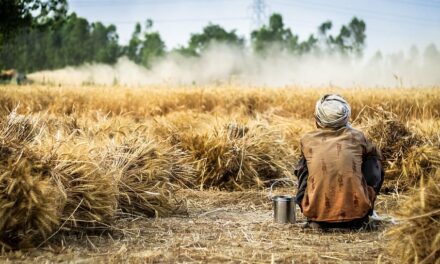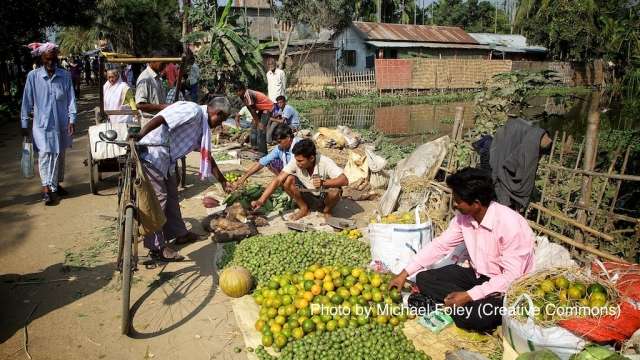By Ayantika Das
According to the Fisheries Statistics of India 2018, a total number of 16,096,975 family members are engaged in fishing activities, out of which 10,526,758 are men and 5,570,217 are women. In spite of occupying a considerable proportion of around 35% of the total workforce in fisheries, women’s role is often invisibilized.
Women play a significant role in the pre- and post-harvest operations in capture fisheries. They are involved in processing fish, net-making, prawn seed collection, fish-drying, curing, and auctioning. They also occupy a significant proportion of the workforce in export-oriented processing. Most importantly of all, women play a leading role in the marketing and selling the fish. They take charge of the catch and sell the fish, contributing to household income, food security, and to the local economy overall.
These contributions often go unrecognized, creating multiple challenges for women fishworkers. With the rise in mechanization over the last few years, fish landing centers (Fish landing centres are initial centres of fish handling) have become more centralized. This has made it difficult for women to access fish as they have to travel longer distance to reach these centers. Women also face difficulty in accessing credit, as most of them are not registered with cooperatives. Without sufficient credit and capital, women vendors struggle to compete with large-scale traders. They are often prevented from using public transport because of social stigmas, making it even more difficult for them to travel to landing centers and markets. At the market itself, women vendors face additional challenges. They must pay to occupy informal vending zones, which lack of basic infrastructure, like toilets, waiting areas, and lights. These circumstances, place women at risk of sexual abuse and harassment.
When the COVID-19 hit India, women fishworkers were already facing these gender-specific challenges. The pandemic has only exacerbated them.
We speak with Jesu Rethinam Christy, a leader within the National Fish workers Forum (NFF), to understand the impact of the COVID-19 lockdown on small-scale fishworkers, especially women.
Question: What has been the impact of the COVID-19 lockdown on small-scale fishworkers, particularly women fishworkers, in India?
JC: The COVID-19 pandemic and the subsequent lockdown have wreaked havoc on the marine capture fisheries, which were already facing tough times before the crisis. There were several regions along the Indian coast where fishing was temporarily halted for various reasons. The new fishing season had just begun after the lean period (rough season) in mid-January, but it was immediately followed by strikes. For instance, there was an ongoing fishery strike in the Tuticorin region regarding permits for stay on fishing. There was another one-month fishing strike across the entire Nagapattinam region in Tamil Nadu due to conflict between ring seine fishers and other fishers. By mid-March, fishers were just about getting ready to get back to sea and salvage what was left of the fishing season. But just then, COVID-19 hit India, prompting many coastal states to announce major restrictions on movement, and all of India was placed under lockdown by the fourth week of March.
Both inland and marine fisherfolk were completely inactive during the first phase of the lockdown, meaning a total loss of income for millions of small-scale fishworker families. After the first phase of the lockdown, the central government eased restrictions on the fisheries sector. However, that did not really help the fishing communities. Central landing of fish was prohibited, which meant loss of livelihood, loss of daily income, and, more importantly, loss of access to fish as part of daily diets. Fisherwomen who constitute a majority of fish vendors at markets were hit the hardest by the drop in daily income. Women, especially single women, who constitute a majority of fish vendors at markets, by the roadside, and by head-loading for door-to-door sale – were also hit by the loss of access to fish, the absence of transport systems, and the loss of access to markets and consumers. Their day-to-day subsistence took a hit, and household incomes were severely impacted.
The situation hasn’t changed much since. Even after the lockdown was revoked in June, there remained major restrictions on the movement of goods, interstate travel, and fish supply chains. Therefore, while fishers have been free to go to sea, there have been no buyers, as market linkages have all but collapsed. Without public transport services, fisherwomen cannot travel to sell their fish in nearby towns and markets. Women, who are already vulnerable due to the existing stigma in the society, have avoided house-to-house fish sales. Most women have stayed home due to the risks they face traveling in public. On top of this, many fishers have been unable to refurbish their boats to resume fishing, as the logistics for maintenance parts were also affected.
The lockdown has presented several existential threats to fishing communities, compounding the effect of laws and policies that have deregulated the fisheries sector, labor, and investment. For the fishers, the old saying remains true: “The sharks in the sea are not a problem, but the sharks on land are.”
Question: What do you think of the government’s response to the pandemic and its effect on women fishworkers?
JC: The government’s relief mechanisms have been geared toward the formalized economy and the industrialized food system. At their core, such responses have deepened the power imbalances between the industrialized food system and transnational corporations on the one hand and small-scale food producers on the other.
Most fishers, especially women fishworkers, have been excluded from welfare measures announced by the central government. After the first few weeks of the lockdown, some state governments announced fisher-specific relief schemes, but those were not sufficient. When various fisher groups, including the NFF, raised concerns about relief measures for fishers, the central government responded by allowing fishing activities, but it made no plans related to the vast forward and backward linkages that make fishing viable.
Moreover, the government did not come up with proper guidelines to keep fish markets in operation, so business has remained slow. The NFF carried out a sustained campaign to demand substantive guidelines regarding both fishing and marketing. Under this pressure, state governments and coastal district administrators finally came out with a number of plans by mid-April. Under these guidelines in Kerala and parts of Tamil Nadu, only a few boats were permitted venture into the sea every day. This was proven unfeasible because limiting the number of boats allowed to fish created rifts within fishing communities. Fishers rejected these restrictions.
In addition, community leaders were worried that even if a few fishers were to test positive for the virus, the entire fishing community would be stigmatized by the rest of society. Hence, fishing has not really taken place throughout the lockdown period.
With over three months of almost no fishing activity, scant relief and welfare measures from the government, and mounting debts, there remains immense anxiety among the fishing communities about what the future holds. To make matters worse, fuel prices have shot up, leaving many fishers wondering if fishing can ever be viable anymore.
Question: In the absence of fully functioning markets, fishworkers from some countries have demanded for more digitalization and have demanded that their governments facilitate e-commerce retail for fisheries. In India, we have witnessed fishworker groups taking a stand against e-commerce. Do you continue to oppose the e-commercialization of fisheries? What do you think will be the impact of such new forms of retail on the lives of women fishworkers?
Question: Fishworkers have already started to go back to work even with the number of infections rising every day. Has the government issued proper guidelines on Standard Operating Procedures (SOPs)?
JC: The government has issued certain SoPs for fishworkers venturing into the sea for fishing. However, there are no guidelines for women fishworkers involved in vending, auctioning, and other post-harvest activities. Due to lack of guidelines, women are not being allowed to enter the harbors or landing centers, which now remain completely reserved for big traders. This also means that women have to buy fish at higher prices from these traders instead of being able to procure the fish themselves, as they used to do.
Question: The government has released the Draft Fisheries Policy in the middle of the pandemic. What are the implications of the draft policy for women fish workers?
JC: Women fishworkers are almost invisible in the policy – mentioned only four or five times in the entire draft. The government also does not have comprehensive data on women in the fisheries sector.
This policy disrespects and disregards traditional fishers as it identifies traditional fishing methods and equipment as some of the major constraints for the development of the fisheries sector. It also pushes for modern fish harbors, catch-to-consumer e-market models, vending registration, and licensing. There is also a proposal for fish traceability monitoring of vendors by coast guard and marine police. All these measures will definitely lead to the displacement of women fish vendors from the fishing sector.
The draft lays excessive stress on quality of fish, traceability, and improved export standards, which will automatically invite more private entities into fishing, as well as post-harvest infrastructure supply chains. This will strengthen the existing developed seafood market monopolies, which will completely exclude the women fish vendors from the post-harvest sector.
Ayantika Das is Program Officer with Focus on the Global South based in New Delhi, India.










